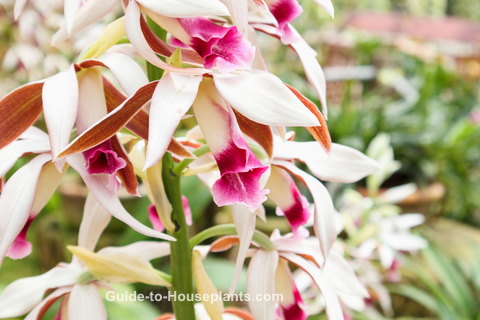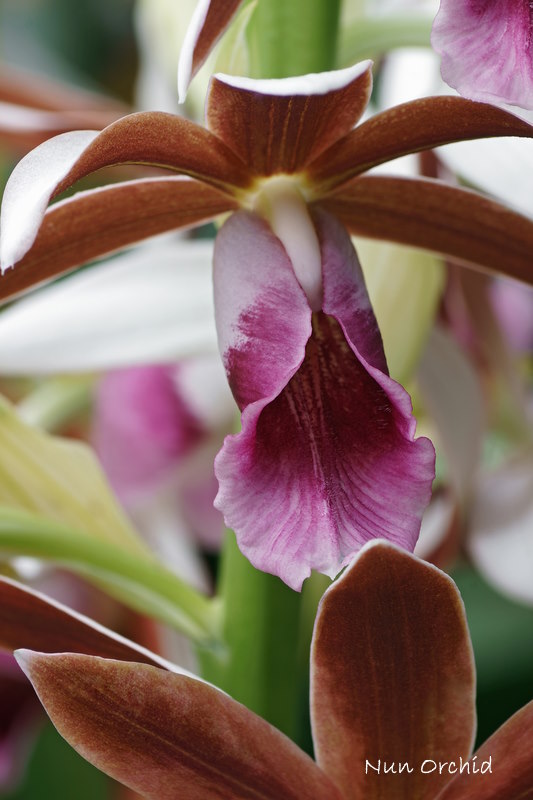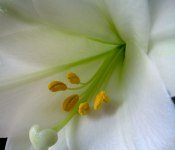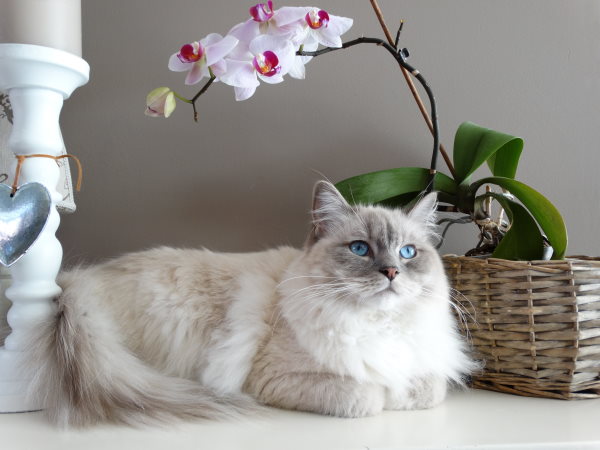Nun Orchid Care
Nun orchid is named for its curved upper sepal and petals that are white on the back side, resembling a nun's cap.
Recognized botanically as Phaius tankervilleae, this beauty is also known as nun's cap orchid, nun's hood, swamp orchid, and lady tankervilleae.
Of the 50 or so species in the Phaius genus, only tankervilleae and its hybrids are likely to be grown indoors. In fact, these spectacular orchids have a preference for moderate light and warm temperatures, making them easier to please in homes than many other orchids. This is an impressive flowering houseplant for the beginner.
 Gorgeous flowers cover the tall stems of nun orchid in spring.
Gorgeous flowers cover the tall stems of nun orchid in spring.Get to Know Nun Orchid
Those tall spikes carrying clusters of 10 to 20 flowers will appear in spring, blooming in succession and lasting for several weeks. Each flower, ranging from brown to maroon -- often with a pink or white lip -- reaches up to 4 inches (10 cm) wide and is delightfully fragrant.
Nun orchid has origins in China, Indonesia and Malaysia, where they are ground-dwellers. How big does it get? You can expect your indoor plant to reach a height of 3 ft (1 m) or more, when it is flowering.
No blooms? Fertilizing this orchid will give it more blooming power. Also put it in bright, indirect light. Plants that don't get enough sunlight all year-round may not bloom.
Give it a winter rest. Give your nun's cap orchid a cool winter to trigger blooming in spring. This lowland forest native will tolerate cold (see "Temperature" below) and needs a cooler-than-normal treatment to bring on those blooms. Also cut back on watering, giving your orchid just enough water to prevent it from drying out.
Repot every 2 or 3 years after plant is done flowering. This is a good time to divide pseudobulbs for more plants. Use a deep pot.
Something bugging your orchid? Aphids are green, leggy insects attracted to new growth on plants, including flower buds. Look over your plant regularly for an infestation. Aphids suck plant juices and if left untreated, will multiply quickly, causing distorted growth. Try to wipe them off with a damp cloth before resorting to an insecticide.
 Image © Nikolai Kurzenko | Dreamstime.com
Image © Nikolai Kurzenko | Dreamstime.comIndoor Nun Orchid Care
Light: Bright indirect light year-round.
Water: Phaius tankervilleae is a terrestrial in its native habitat so it needs more moisture than many orchids. Keep potting medium moist but not soggy, which leads to root rot. Try to avoid splattering water on the leaves because black spots may appear. Water sparingly during the winter.
Humidity: Moderate (50% relative humidity). Raise the humidity, if needed by setting your orchid plant on a humidity tray or use a cool-mist room humidifier.
Temperature: Average room temperatures (65-75°F/18-24°C), except for a cool winter (55-60°F/13-16°C) to set buds. It will tolerate temps as low as 40°F/5°C.
Soil: Orchid potting mix; keep the mix loose (don't pack it down).
Fertilizer: Use a balanced orchid fertilizer with every third watering spring through fall. Stop fertilizing while plant is resting in winter.
Propagation: Divide mature plants after they flower by cutting the rhizome with a sharp knife. Each piece should have at least 2 pseudobulb shoots and some roots attached.


